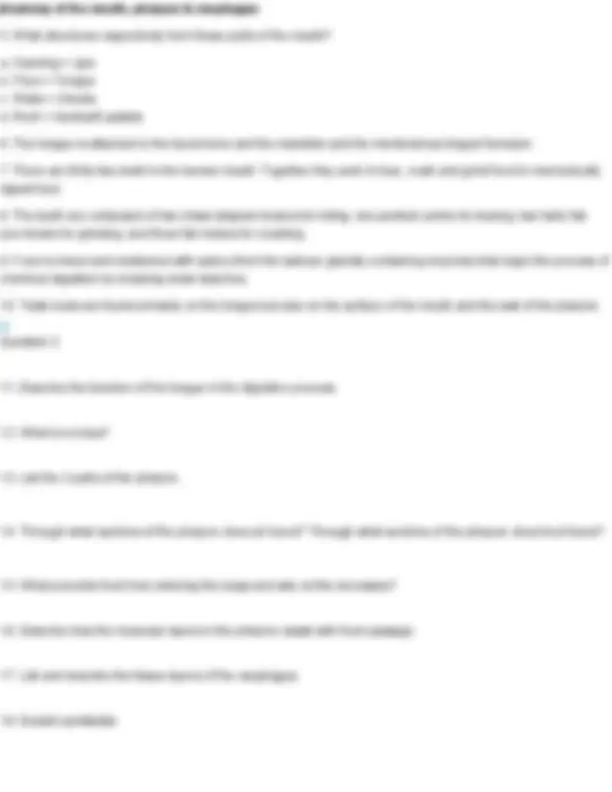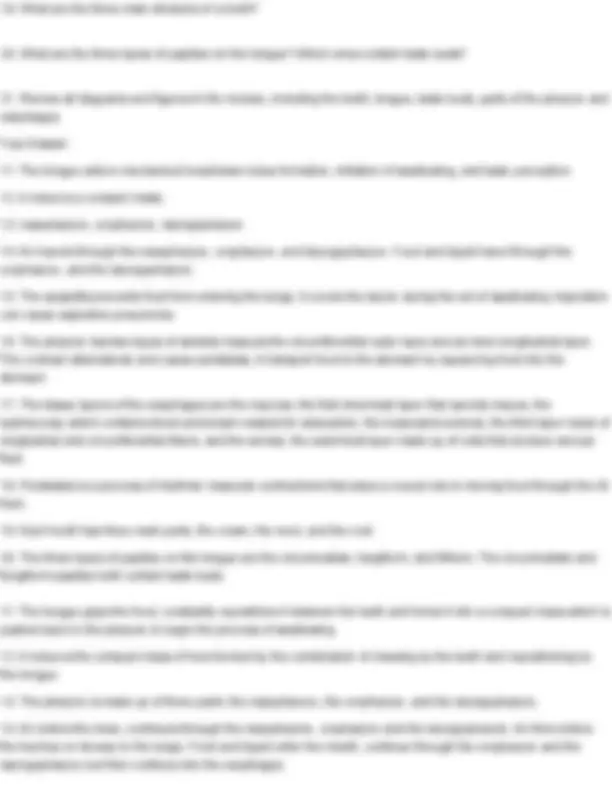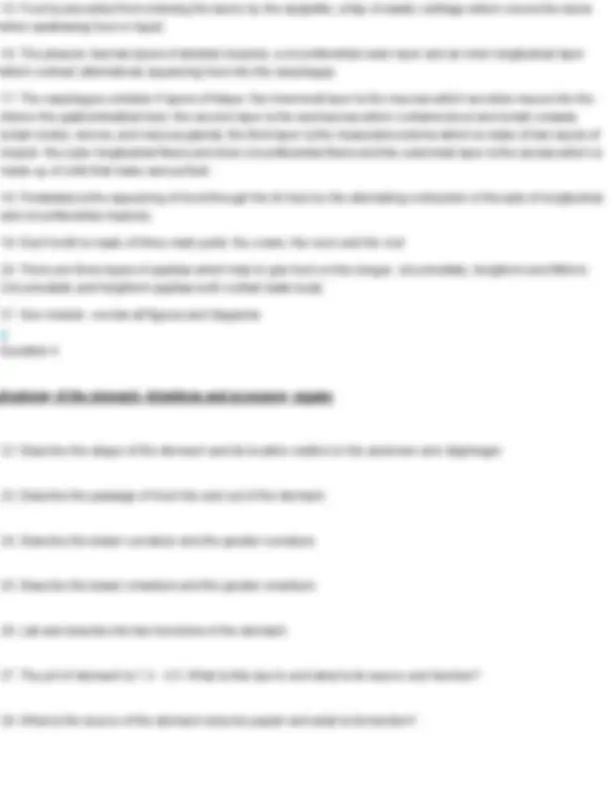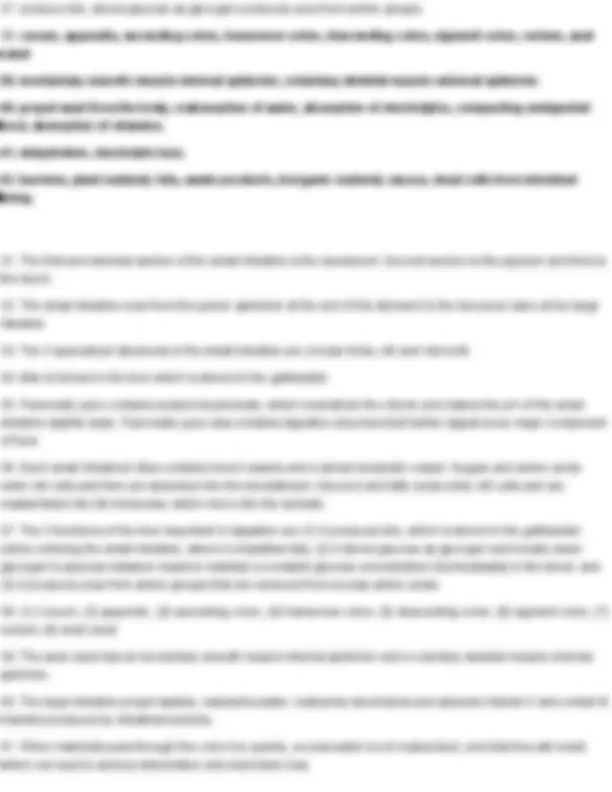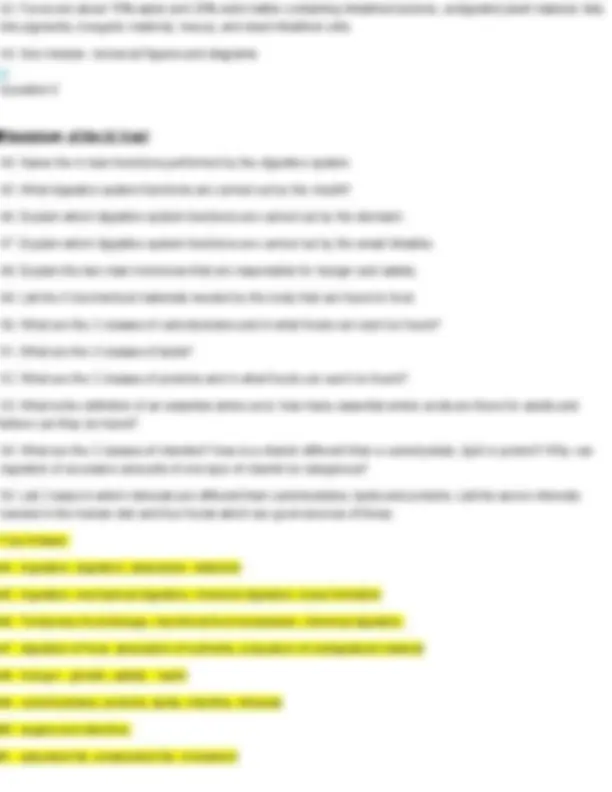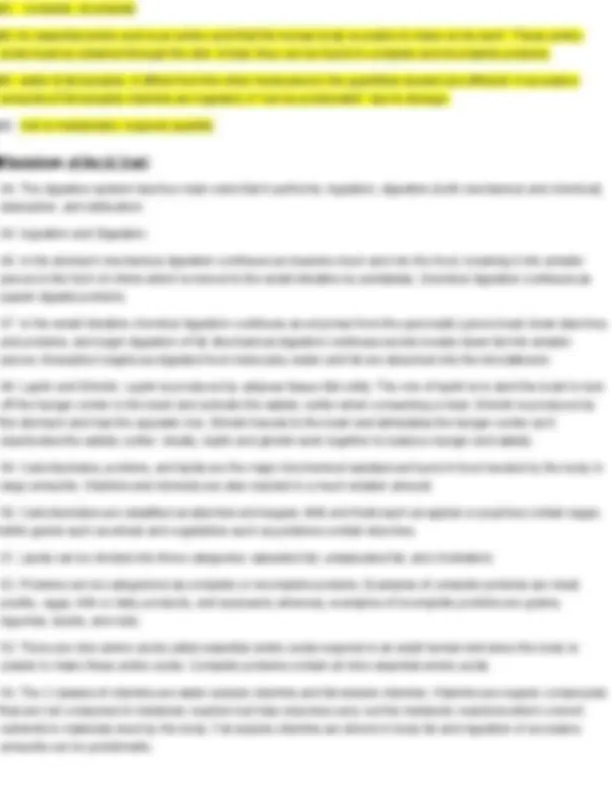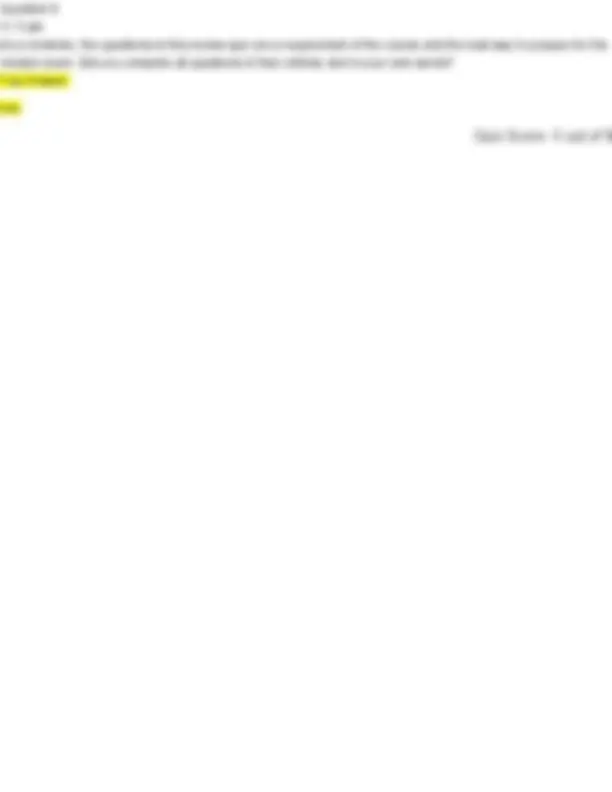Download Module 3: Problem Set: Essential Human Anatomy & Physiology I w/Lab - Burtt - 2025E and more Exams Anatomy in PDF only on Docsity!
Module 3: Problem Set
Due No due date Points 5 Questions 8 Time Limit None
Attempt History
Attempt Time Score LATEST Attempt^1 9,167 minutes 5 out of 5 Submitted Jun 13 at 6:27pm This attempt took 9,167 minutes. Question 1 Digestive System Overview
- Name the two main divisions of the digestive system organs.
- Name the seven parts of the gastrointestinal tract.
- Name the six digestive system accessory organs.
- Review all the figures and diagrams, including the GI tract and accessory organs.
Your Answer:
- Two divisions of the digestive system organs are the alimentary canal and the accessory digestive organs.
- Several parts of the GI tracts are the following: mouth, pharynx, esophagus, stomach, small intestine, large
intestine, anus.
- The six digestive system accessory organs are the following: the teeth, tongue, gallbladder, salivary glands,
liver, pancreas, gallbladder, liver. Digestive System Overview
- The human digestive organs can be divided into those of the alimentary canal and the accessory digestive
organs.
- The gastrointestinal tract is composed of the mouth, pharynx, esophagus, stomach, small intestine, large
intestine, and anus.
- The accessory organs are the teeth, tongue, gallbladder, salivary glands, liver and pancreas.
- See module – review all figures and diagrams
Question 2 Anatomy of the mouth, pharynx & esophagus
- What structures respectively form these parts of the mouth?
- List the two bones and the membrane to which the tongue is attached.
- How many teeth are there in an adult human and what do they do?
- What are the four types of teeth, how many of each type are there and what does each type do?
- What is the specific function of the salivary gland in the process of digestion?
- Where are taste buds located?
Your Answer:
- The opening of the the mouth is formed by the lips, the floor of the mouth is formed by the tongue, the
cheeks for the walls, the hard and soft palates form the roof.
- The tongue attaches to the hyoid bone, mandible, and lingual frenulum.
- Adult humans have 32 teeth. Teeth perform the mechanical process of mastication.
- The four types of teeth are the following: Incisors (2) used for biting, the canines (2) used for tearing, the
premolars (4) used for grinding, and the molars (6) used for crushing.
- The salivary glands play a crucial role in the initial stages of digestion within the mouth.
- Taste buds are located on the tongue within the circumvallate and fungiform papillae, on the surface of the
mouth, and the wall of the pharynx. a. Opening b. Floor c. Walls d. Roof
- What are the three main divisions of a tooth?
- What are the three types of papillae on the tongue? Which ones contain taste buds?
- Review all diagrams and figures in the module, including the teeth, tongue, taste buds, parts of the pharynx and
esophagus. Your Answer:
- The tongue aids in mechanical breakdown bolus formation, initiation of swallowing, and taste perception.
- A bolus is a compact mass.
- nasopharynx, oropharynx, laryngopharynx
- Air travels through the nasopharynx, oropharynx, and laryngopharynx. Food and liquid travel through the
oropharynx, and the laryngopharynx.
- The epiglottis prevents food from entering the lungs, it covers the larynx during the act of swallowing. Aspiration
can cause aspiration pneumonia.
- The pharynx has two types of skeletal musculs the circumferential outer layer and an inner longitudinal layer.
The contract alternatively and cause peristalsis, it transport food to the stomach by squezzing food into the stomach.
- The tissue layers of the esophagus are the mucosa; the first innermost layer that secrets mucus, the
submucosa; which contains blood and lymph vessels for absorption, the muscularis externa; the third layer made of longitudinal and circumferential fibers, and the serosa; the outermost layer made up of cells that produce serous fluid.
- Peristalsis is a process of rhythmic muscular contractions that plays a crucial role in moving food through the GI
tract.
- Each tooth has three main parts, the crown, the neck, and the root.
- The three types of papillae on the tongue are the circumvallate, fungiform, and filiform. The circumvallate and
fungiform papillae both contain taste buds.
- The tongue grips the food, constantly repositions it between the teeth and forms it into a compact mass which is
pushed back to the pharynx to begin the process of swallowing.
- A bolus is the compact mass of food formed by the combination of chewing by the teeth and repositioning by
the tongue.
- The pharynx is made up of three parts: the nasopharynx, the oropharynx, and the laryngopharynx.
- Air enters the nose, continues through the nasopharynx, oropharynx and the laryngopharynx. Air then enters
the trachea on its way to the lungs. Food and liquid enter the mouth, continue through the oropharynx and the laryngopharynx but then continue into the esophagus.
- Food is prevented from entering the larynx by the epiglottis, a flap of elastic cartilage which covers the larynx
when swallowing food or liquid.
- The pharynx has two types of skeletal muscles; a circumferential outer layer and an inner longitudinal layer
which contract alternatively squeezing food into the esophagus.
- The esophagus contains 4 layers of tissue: the innermost layer is the mucosa which secretes mucus into the
interior the gastrointestinal tract, the second layer is the submucosa which contains blood and lymph vessels, lymph nodes, nerves, and mucous glands, the third layer is the muscularis externa which is made of two layers of muscle: the outer longitudinal fibers and inner circumferential fibers and the outermost layer is the serosa which is made up of cells that make serous fluid.
- Peristalsis is the squeezing of food through the GI tract by the alternating contraction of the sets of longitudinal
and circumferential muscles.
- Each tooth is made of three main parts: the crown, the neck and the root
- There are three types of papillae which help to grip food on the tongue: circumvallate, fungiform and filiform.
Circumvallate and fungiform papillae both contain taste buds.
- See module – review all figures and diagrams
Question 4 Anatomy of the stomach, intestines and accessory organs
- Describe the shape of the stomach and its location relative to the abdomen and diaphragm.
- Describe the passage of food into and out of the stomach.
- Describe the lesser curvature and the greater curvature.
- Describe the lesser omentum and the greater omentum.
- List and describe the two functions of the stomach.
- The pH of stomach is 1.3 - 3.5. What is this due to and what is its source and function?
- What is the source of the stomach enzyme pepsin and what is its function?
- Inactive pepsinogen is secreted by the chief cells and converted into the active enzyme pepsin by HCl. Pepsin
then begins the breakdown of proteins.
- A stomach ulcer is an open sore in the wall of the stomach
- The pyloric sphincter valve, located at the base of the stomach, relaxes causing a small quantity of chyme to
pass through the opening into the first part of the small intestine. This initiates a reflex that causes the muscles of the sphincter to contract and close the opening temporarily. Then the sphincter relaxes again and allows more chyme to enter. Question 5
- List the 3 sections of the small intestine. Which section is the shortest?
- What are the names of the valves which are located at the beginning and end of the small intestine?
- List the names of the 3 specialized structures in the wall of the small intestine.
- Where is bile formed and stored?
- Describe in detail the 2 major functions of pancreatic juice.
- Describe how fats, sugars and amino acids are absorbed by the small intestine.
- What are the 3 functions of the liver that are important in digestion?
- List the 8 regions of the large intestine.
- What are the two sphincters of the anal canal?
- List 4 functions of the large intestine.
- What are the 2 major physiological problems caused by diarrhea?
- List the content of feces.
- Review all figures and diagrams, including all regions of the stomach, intestines, and accessory organs.
Your Answer:
- Duodenum, jejunum, ileum.
- pyloric sphincter (beginning) , ileocecal valve (closing)
- Circular folds, vili, microvilli
- Liver
- neutralize chyme, provide digestive enzyme.
- Sugar and amino acids enter the cells of the villi. Fats absorbed though lacteals after being digested by bile and
broken down into glycerol and fatty acids.
- produce bile, stores glucose as glycogen produces urea from amino groups.
- cecum, appendix, ascending colon, transverse colon, descending colon, sigmoid colon, rectum, anal
canal
**39. involuntary smooth muscle internal sphincter, voluntary skeletal muscle external sphincter.
- propel wast from the body, reabsorption of water, absorption of electrolytes, compacting undigested**
food, absorption of vitamins.
**41. dehydration, electrolyte loss.
- bacteria, plant material, fats, waste products, inorganic material, mucus, dead cells from intestinal**
lining.
- The first and shortest section of the small intestine is the duodenum. Second section is the jejunum and third is
the ileum.
- The small intestine runs from the pyloric sphincter at the end of the stomach to the ileocecal valve at the large
intestine.
- The 3 specialized structures in the small intestine are circular folds, villi and microvilli.
- Bile is formed in the liver which is stored in the gallbladder.
- Pancreatic juice contains sodium bicarbonate, which neutralizes the chyme and makes the pH of the small
intestine slightly basic. Pancreatic juice also contains digestive enzymes that further digest every major component of food.
- Each small intestinal villus contains blood vessels and a lacteal lymphatic vessel. Sugars and amino acids
enter villi cells and then are absorbed into the bloodstream. Glycerol and fatty acids enter villi cells and are reassembled into fat molecules, which move into the lacteals.
- The 3 functions of the liver important in digestion are (1) it produces bile, which is stored in the gallbladder
before entering the small intestine, where it emulsifies fats, (2) it stores glucose as glycogen and breaks down glycogen to glucose between meals to maintain a constant glucose concentration (homeostasis) in the blood, and (3) it produces urea from amino groups that are removed from excess amino acids.
- (1) Cecum, (2) appendix, (3) ascending colon, (4) transverse colon, (5) descending colon, (6) sigmoid colon, (7)
rectum, (8) anal canal
- The anal canal has an involuntary smooth muscle internal sphincter and a voluntary skeletal muscle external
sphincter.
- The large intestine propel wastes, reabsorbs water, reabsorbs electrolytes and absorbs Vitamin K and certain B
vitamins produced by intestinal bacteria.
- When materials pass through the colon too quickly, excess water is not reabsorbed, and diarrhea will result,
which can lead to serious dehydration and electrolyte loss.
- complete, incomplete
- An essential amino acid is an amino acid that the human body is unable to make on its own1. These amino
acids must be obtained through the diet. 9 total, they can be found in complete and incomplete proteins.
- water & fat soluable. it differs from the other molecules bc the quantities needed are different. if excessive
amounts of fat soluable vitamins are ingested, it "can be problematic" due to storage.
- role in metabolism, required quantity
Physiology of the GI Tract
- The digestive system has four main roles that it performs: ingestion, digestion (both mechanical and chemical),
absorption, and defecation.
- Ingestion and Digestion.
- In the stomach mechanical digestion continues as muscles churn and mix the food, breaking it into smaller
pieces in the form of chime which is moved to the small intestine by peristalsis. Chemical digestion continues as pepsin digests proteins.
- In the small intestine chemical digestion continues as enzymes from the pancreatic juices break down starches
and proteins, and begin digestion of fat. Mechanical digestion continues as bile breaks down fat into smaller pieces. Absorption begins as digested food molecules, water and fat are absorbed into the bloodstream.
- Leptin and Ghrelin. Leptin is produced by adipose tissue (fat cells). The role of leptin is to alert the brain to turn
off the hunger center in the brain and activate the satiety center when consuming a meal. Ghrelin is produced by the stomach and has the opposite role. Ghrelin travels to the brain and stimulates the hunger center as it deactivates the satiety center. Ideally, leptin and ghrelin work together to balance hunger and satiety.
- Carbohydrates, proteins, and lipids are the major biochemical substances found in food needed by the body in
large amounts. Vitamins and minerals are also needed in a much smaller amount.
- Carbohydrates are classified as starches and sugars. Milk and fruits such as apples or peaches contain sugar,
while grains such as wheat and vegetables such as potatoes contain starches.
- Lipids can be divided into three categories: saturated fat, unsaturated fat, and cholesterol.
- Proteins can be categorized as complete or incomplete proteins. Examples of complete proteins are meat,
poultry, eggs, milk or dairy products, and soybeans; whereas, examples of incomplete proteins are grains, legumes, seeds, and nuts.
- There are nine amino acids called essential amino acids required in an adult human diet since the body is
unable to make these amino acids. Complete proteins contain all nine essential amino acids.
- The 2 classes of vitamins are water-soluble vitamins and fat-soluble vitamins. Vitamins are organic compounds
that are not consumed in metabolic reaction but help enzymes carry out the metabolic reactions which convert nutrients to materials need by the body. Fat-soluble vitamins are stored in body fat and ingestion of excessive amounts can be problematic.
- Minerals are inorganic compounds (not organic like carbohydrates, lipids and proteins) and are not used as fuel
in metabolic reactions. Humans need the following seven minerals in their diets: calcium, chloride, magnesium, phosphorus, potassium, sodium, and sulfur. Foods such as milk, some meats, legumes and vegetables are the best sources of minerals. Question 7 Physiology of the GI Tract Part II: Cellular Metabolism
- Define anabolism.
- How is the energy released from the breakdown of glucose used by the body?
- Describe cellular respiration.
- Describe glycolysis.
- Describe the citric acid cycle (TCA cycle).
- Describe the electron transport chain.
- How is the energy released in the breakdown of glucose converted to a form usable by the cells?
- How does the energy formed in fat catabolism compare to that formed in carbohydrate metabolism?
- Name, tell the location of and explain in detail the first stage of lipid breakdown.
- Why are proteins not usually used as a body energy source and when are they used?
- What is the first step in the oxidation of an amino acid formed from a protein?
- Explain in detail how ammonia is removed from the body.
- Review all diagrams and figures.
Your Answer:
- Anabolism is defined as the set of reactions in which smaller molecules are combined to make larger, more
complex molecules
- to generate ATP
- Cellular respiration is defined as the process by which cells generate adenosine triphosphate (ATP)
- Glycolysis is the first step in glucose metabolism and cellular respiration. It is the process where a single 6 -
carbon molecule of glucose is broken down into two 3-carbon pyruvate molecules.
- he Tricarboxylic Acid (TCA) Cycle, also known as the Krebs Cycle or the citric acid cycle, is a central pathway of
cellular respiration
- the electron transport chain is the final and most productive stage of aerobic cellular respiration, where the
energy stored in electron carriers (NADH and FADH2) is efficiently converted into a large number of ATP molecules, essential for cellular survival.
Question 8 5 / 5 pts As a reminder, the questions in this review quiz are a requirement of the course and the best way to prepare for the module exam. Did you complete all questions in their entirety and in your own words? Your Answer: yes.
Quiz Score: 5 out of 5

